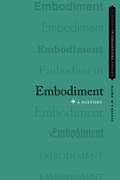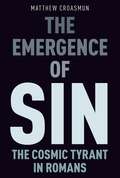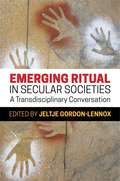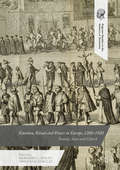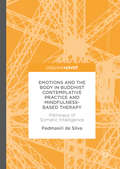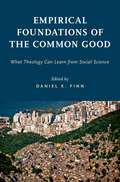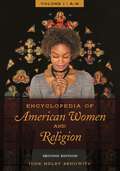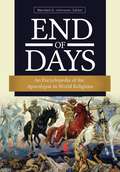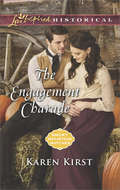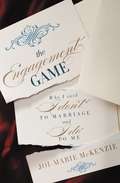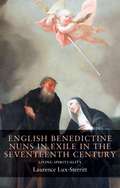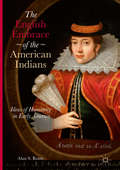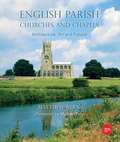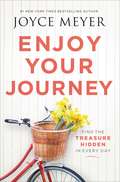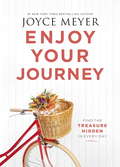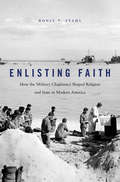- Table View
- List View
EMBODIMENT OPC C: A History (Oxford Philosophical Concepts)
by Justin E. H. SmithEmbodiment--defined as having, being in, or being associated with a body--is a feature of the existence of many entities, perhaps even of all entities. Why entities should find themselves in this condition is the central concern of the present volume. The problem includes, but also goes beyond, the philosophical problem of body: that is, what the essence of a body is, and how, if at all, it differs from matter. On some understandings there may exist bodies, such as stones or asteroids, that are not the bodies of any particular subjects. To speak of embodiment by contrast is always to speak of a subject that variously inhabits, or captains, or is coextensive with, or even is imprisoned within, a body. The subject may in the end be identical to, or an emergent product of, the body. That is, a materialist account of embodied subjects may be the correct one. But insofar as there is a philosophical problem of embodiment, the identity of the embodied subject with the body stands in need of an argument and cannot simply be assumed. The reasons, nature, and consequences of the embodiment of subjects as conceived in the long history of philosophy in Europe as well as in the broader Mediterranean region and in South and East Asia, with forays into religion, art, medicine, and other domains of culture, form the focus of these essays. More precisely, the contributors to this volume shine light on a number of questions that have driven reflection on embodiment throughout the history of philosophy. What is the historical and conceptual relationship between the idea of embodiment and the idea of subjecthood? Am I who I am principally in virtue of the fact that I have the body I have? Relatedly, what is the relationship of embodiment to being and to individuality? Is embodiment a necessary condition of being? Of being an individual? What are the theological dimensions of embodiment? To what extent has the concept of embodiment been deployed in the history of philosophy to contrast the created world with the state of existence enjoyed by God? What are the normative dimensions of theories of embodiment? To what extent is the problem of embodiment a distinctly western preoccupation? Is it the result of a particular local and contingent history, or does it impose itself as a universal problem, wherever and whenever human beings begin to reflect on the conditions of their existence? Ultimately, to what extent can natural science help us to resolve philosophical questions about embodiment, many of which are vastly older than the particular scientific research programs we now believe to hold the greatest promise for revealing to us the bodily basis, or the ultimate physical causes, of who we really are?
The Emergence of Sin: The Cosmic Tyrant in Romans
by Matthew CroasmunWe can have a sense that when we try to do right by one another, we aren't merely striving against ourselves. The feeling is that we are struggling against something--someone-else. As if there's a force-a person- that wishes us ill. In his letter to the Romans, the apostle Paul describes just such a person: Sin, a cosmic tyrant who constrains our moral freedom, confuses our moral judgment, and condemns us to slavery and to death. Commentators have long argued about whether Paul literally means to say Sin is a person or is simply indulging in literary personification, but regardless of Paul's intentions, for modern readers it would seem clear enough: there is no such thing as a cosmic tyrant. Surely it is more reasonable to suppose "Sin" is merely a colorful way of describing individual misdeeds or, at most, a way of evoking the intractability of our social ills. In The Emergence of Sin, Matthew Croasmun suggests we take another look. The vision of Sin he offers is at once scientific and theological, social and individual, corporeal and mythological. He argues both that the cosmic power Sin is nothing more than an emergent feature of a vast human network of transgression and that this power is nevertheless real, personal, and one whom we had better be ready to resist. Ultimately, what is on offer here is an account of the world re-mythologized at the hands of chemists, evolutionary biologists, sociologists, and entomologists. In this world, Paul's text is not a relic of a forgotten mythical past, but a field manual for modern living.
Emerging Ritual in Secular Societies: A Transdisciplinary Conversation
by Robert C. Scaer Michael Picucci Matthieu Smyth Lindy Mechefske Joanna Wojtkowiak Jeltje Gordon-Lennox Jacqueline Millner Isabel Russo Irene Stengs Gianpiero Vincenzo Ellen Dissanayake Christine Behrend Andrés Allemand SmallerThe growing absence of meaningful ritual in contemporary Western societies that has led to cohesive research of the history of ritualizing behaviour and traditional events in different cultures. The relatively new field of ritology which includes neuroscience, anthropology, cultural psychology, psychotherapy, and even art and performance, raises questions about the significance and practice of ritual today. While there is widespread literature on religious rites and practice, this book is the first of its kind to discuss the importance of secular rituals for cultural and personal growth. The contributors will provide an authoritative account of the science and history of rituals and their role in creating healthy societies in the modern age.
Emerging Ritual in Secular Societies: A Transdisciplinary Conversation (PDF)
by Andrés Allemand Smaller Christine Behrend Ellen Dissanayake Gianpiero Vincenzo Irene Stengs Isabel Russo Jacqueline Millner Jeltje Gordon-Lennox Joanna Wojtkowiak Lindy Mechefske Matthieu Smyth Michael Picucci Robert C. ScaerThe growing absence of meaningful ritual in contemporary Western societies has led to cohesive research on the history of ritualizing behaviour in different cultures. The relatively new field of ritology, which includes neuroscience, anthropology, cultural psychology, psychotherapy and even art and performance, raises questions about the significance and practice of ritual today. This book is the first of its kind to discuss the importance of secular rituals for cultural and personal growth. Using a transdisciplinary approach, a range of contributors provide an authoritative account of the science and history of rituals and their role in creating healthy societies in the modern age.
Emotion, Ritual and Power in Europe, 1200-1920: Family, State and Church (Palgrave Studies in the History of Emotions)
by Katie Barclay Merridee L. BaileyThis volume spans the fourteenth to nineteenth centuries, across Europe and its empires, and brings together historians, art historians, literary scholars and anthropologists to rethink medieval and early modern ritual. The study of rituals, when it is alert to the emotions which are woven into and through ritual activities, presents an opportunity to explore profoundly important questions about people’s relationships with others, their relationships with the divine, with power dynamics and importantly, with their concept of their own identity. Each chapter in this volume showcases the different approaches, theories and methodologies that can be used to explore emotions in historical rituals, but they all share the goal of answering the question of how emotions act within ritual to inform balances of power in its many and varied forms. Chapter 5 of this book is available open access under a CC BY 4.0 license.
Emotion, Ritual and Power in Europe, 1200–1920: Family, State and Church (Palgrave Studies in the History of Emotions)
by Merridee L. Bailey Katie BarclayThis volume spans the fourteenth to nineteenth centuries, across Europe and its empires, and brings together historians, art historians, literary scholars and anthropologists to rethink medieval and early modern ritual. The study of rituals, when it is alert to the emotions which are woven into and through ritual activities, presents an opportunity to explore profoundly important questions about people’s relationships with others, their relationships with the divine, with power dynamics and importantly, with their concept of their own identity. Each chapter in this volume showcases the different approaches, theories and methodologies that can be used to explore emotions in historical rituals, but they all share the goal of answering the question of how emotions act within ritual to inform balances of power in its many and varied forms. Chapter 5 of this book is available open access under a CC BY 4.0 license.
Emotions and The Body in Buddhist Contemplative Practice and Mindfulness-Based Therapy: Pathways of Somatic Intelligence
by Padmasiri De SilvaThis book represents an outstanding contribution to the field of somatic psychology. It focuses on the relationship between body and emotions, and on the linkages between mindfulness-based emotion studies and neuroscience. The author discusses the awakening of somatic intelligence as a journey through pain and trauma management, the moral dimensions of somatic passions, and the art and practice of embodied mindfulness. Issues such as the emotions and the body in relation to Buddhist contemplative practice, against the background of the most recent findings of current neuroscience, are expanded in the book. A broad review of the Darwinian-Jamesian heritage on emotion studies is a unique contribution to the tradition of the somatogenic strands of emotions, and provides a contrasting focus to the ideogenic emotions in Sigmund Freud. This work provides an invaluable resource for students of psychology and philosophy, psychotherapists and meditation teachers, students, and for anyone with an interest in the field of somatic psychology.
Emotions and The Body in Buddhist Contemplative Practice and Mindfulness-Based Therapy: Pathways of Somatic Intelligence
by Padmasiri De SilvaThis book represents an outstanding contribution to the field of somatic psychology. It focuses on the relationship between body and emotions, and on the linkages between mindfulness-based emotion studies and neuroscience. The author discusses the awakening of somatic intelligence as a journey through pain and trauma management, the moral dimensions of somatic passions, and the art and practice of embodied mindfulness. Issues such as the emotions and the body in relation to Buddhist contemplative practice, against the background of the most recent findings of current neuroscience, are expanded in the book. A broad review of the Darwinian-Jamesian heritage on emotion studies is a unique contribution to the tradition of the somatogenic strands of emotions, and provides a contrasting focus to the ideogenic emotions in Sigmund Freud. This work provides an invaluable resource for students of psychology and philosophy, psychotherapists and meditation teachers, students, and for anyone with an interest in the field of somatic psychology.
Empirical Foundations of the Common Good: What Theology Can Learn from Social Science
by Daniel K. FinnThe idea of the common good was borrowed by the Fathers of the early Catholic Church from the rich philosophical traditions of ancient Greece and Rome. It has been a fundamental part of Catholic thinking about social, political, and economic life throughout the Catholic intellectual tradition, from Augustine and Aquinas to modern Catholic social thought in the encyclicals of popes in recent centuries. Yet this history has been rooted in the traditions of philosophy and theology. With the rise of the social sciences in the nineteenth century as distinct disciplines no longer limited to the methods of their philosophical origins, humanity has learned a great deal more about the human condition. Empirical Foundations of the Common Good asks two questions: what have the social sciences learned about the common good? how might theology alter its understanding of the common good in light of that insight? In this volume, six social scientists, with backgrounds in economics, political science, sociology, and policy analysis, speak about what their disciplines have to contribute to discussions within Catholic social thought about the common good. Two theologians then respond by examining the insights of social science and exploring how Catholic social thought can integrate social scientific insights into its understanding of the common good. This volume's interplay of social scientific and religious views is a unique contribution to contemporary discussion of what constitutes "the common good."
Empirical Foundations of the Common Good: What Theology Can Learn from Social Science
by Daniel K. FinnThe idea of the common good was borrowed by the Fathers of the early Catholic Church from the rich philosophical traditions of ancient Greece and Rome. It has been a fundamental part of Catholic thinking about social, political, and economic life throughout the Catholic intellectual tradition, from Augustine and Aquinas to modern Catholic social thought in the encyclicals of popes in recent centuries. Yet this history has been rooted in the traditions of philosophy and theology. With the rise of the social sciences in the nineteenth century as distinct disciplines no longer limited to the methods of their philosophical origins, humanity has learned a great deal more about the human condition. Empirical Foundations of the Common Good asks two questions: what have the social sciences learned about the common good? how might theology alter its understanding of the common good in light of that insight? In this volume, six social scientists, with backgrounds in economics, political science, sociology, and policy analysis, speak about what their disciplines have to contribute to discussions within Catholic social thought about the common good. Two theologians then respond by examining the insights of social science and exploring how Catholic social thought can integrate social scientific insights into its understanding of the common good. This volume's interplay of social scientific and religious views is a unique contribution to contemporary discussion of what constitutes "the common good."
Encyclopedia of American Women and Religion [2 volumes]: [2 volumes]
by June Melby BenowitzThis two-volume set examines women's contributions to religious and moral development in America, covering individual women, their faith-related organizations, and women's roles and experiences in the broader social and cultural contexts of their times.This second edition of Encyclopedia of American Women and Religion provides updated and expanded information from historians and other scholars of religion, covering new issues in religion to better describe and document women's roles within religious groups. For instance, the term "evangelical feminism" is one newly defined aspect of women's involvement in religious activism. Changes are constantly occurring within the many religious faiths and denominations in America, particularly as women strive to gain positions within religious hierarchies that previously were exclusive to men and rise within their denominations to become theologians, church leaders, and bishops.The entries examine the roles that American women have played in mainstream religious denominations, small religious sects, and non-traditional practices such as witchcraft, as well as in groups that question religious beliefs, including agnostics and atheists. A section containing primary documents gives readers a firsthand look at matters of concern to religious women and their organizations. Many of these documents are the writings of women who merit entries within the encyclopedia. Readers will gain an awareness of women's contributions to religious culture in America, from the colonial era to the present day, and better understand the many challenges that women have faced to achieve success in their religion-related endeavors.
End of Days: An Encyclopedia of the Apocalypse in World Religions
by Wendell G. JohnsonCovering religious traditions ranging from Buddhism to Christianity to Zoroastrianism and modern apocalyptic movements such as Arun Shinrikyo and the Branch Davidians, this book addresses prophesied end of days from a breadth of perspectives and includes material on often-neglected themes and genres.End of Days: An Encyclopedia of the Apocalypse in World Religions describes apocalyptic writings in the world's major religious traditions, including Judaism, Christianity, Islam, Hinduism, and Buddhism. The cross-referenced entries address ancient traditions—Zoroastrianism, as one example—as well as modern apocalyptic movements, such as Arun Shinrikyo, the Branch Davidians, and the Order of the Solar Temple.This book's broad scope offers coverage of overlooked traditions, such as Mayan Apocalyptic, Norse Apocalyptic, Native American eschatological literatures, and the Tibetan Book of the Dead. Readers seeking detailed information on the eschatological and apocalyptic movements and proponents of End Times can reference entries about individuals such as Harold Camping, Jerry Falwell, David Koresh of the Brand Davidians, and James Jones and the People's Temple. This single-volume encyclopedia also contains numerous historical entries on subjects such as the Great Disappointment, the Great Awakening periods of religious revival, Joachim of Flora, the Maccabean Revolt, and the Plymouth Brethren. The influence of apocalyptic ideas far outside the realm of religion itself is documented through entries on film, including well-known modern movies such as The Hunger Games and Apocalypse Now, literature by writers such as Dante, and works of fine art like Wagner's Götterdämmerung. The inclusion of entries related to literature, film, and other art forms further attests to the wide-ranging social influence of belief in the end of days.
End of Days: An Encyclopedia of the Apocalypse in World Religions
by Wendell G. JohnsonCovering religious traditions ranging from Buddhism to Christianity to Zoroastrianism and modern apocalyptic movements such as Arun Shinrikyo and the Branch Davidians, this book addresses prophesied end of days from a breadth of perspectives and includes material on often-neglected themes and genres.End of Days: An Encyclopedia of the Apocalypse in World Religions describes apocalyptic writings in the world's major religious traditions, including Judaism, Christianity, Islam, Hinduism, and Buddhism. The cross-referenced entries address ancient traditions—Zoroastrianism, as one example—as well as modern apocalyptic movements, such as Arun Shinrikyo, the Branch Davidians, and the Order of the Solar Temple.This book's broad scope offers coverage of overlooked traditions, such as Mayan Apocalyptic, Norse Apocalyptic, Native American eschatological literatures, and the Tibetan Book of the Dead. Readers seeking detailed information on the eschatological and apocalyptic movements and proponents of End Times can reference entries about individuals such as Harold Camping, Jerry Falwell, David Koresh of the Brand Davidians, and James Jones and the People's Temple. This single-volume encyclopedia also contains numerous historical entries on subjects such as the Great Disappointment, the Great Awakening periods of religious revival, Joachim of Flora, the Maccabean Revolt, and the Plymouth Brethren. The influence of apocalyptic ideas far outside the realm of religion itself is documented through entries on film, including well-known modern movies such as The Hunger Games and Apocalypse Now, literature by writers such as Dante, and works of fine art like Wagner's Götterdämmerung. The inclusion of entries related to literature, film, and other art forms further attests to the wide-ranging social influence of belief in the end of days.
The Engagement Game: Why I Said "I Don't" to Marriage and "I Do" to Me
by Joi-Marie McKenzieJoi-Marie almost has it all; a thriving career, a supportive family, great friends, and an apartment in Manhattan. What she doesn't have is a husband. Ambitious, confident, and successful, Joi-Marie believes she has it all figured out. At 28 years old, she has an enviable job as a producer, covering entertainment in New York City. Her close-knit family is loving and encouraging, and her boyfriend, Adam, is as close to perfect as you can get -- except for the fact that he won't propose. Like most women, Joi-Marie has a checklist of what the perfect life looks like. She has the career, the friends, the apartment, and the lifestyle she has always wanted. But, when the husband she wants doesn't fall into place, she decides to play the game-the engagement game-in order to get Adam to drop down on one knee. After receiving a laundry list of advice on how to secure a proposal--even researching how to cook "engagement chicken"-- Joi-Marie realizes that, in the process of trying to attain her perfect life, she has slowly become a person she doesn't recognize. With this discovery, she must make a decision: pretend to be someone she's not in order to have the life she envisioned...or have the courage to be herself and find her happily ever after in a way she never expected.
English Benedictine nuns in exile in the seventeenth century: Living spirituality (Seventeenth- And Eighteenth-century Studies)
by Laurence Lux-SterrittProvides the first detailed and interdisciplinary analysis of the English Benedictine communities in exile during the seventeenth century, looking at their lived experiences, emotions and senses in religious life.
English Benedictine nuns in exile in the seventeenth century: Living spirituality (Seventeenth- And Eighteenth-century Studies)
by Laurence Lux-SterrittThis study of English Benedictine nuns is based upon a wide variety of original manuscripts, including chronicles, death notices, clerical instructions, texts of spiritual guidance, but also the nuns' own collections of notes. It highlights the tensions between the contemplative ideal and the nuns' personal experiences, illustrating the tensions between theory and practice in the ideal of being dead to the world. It shows how Benedictine convents were both cut-off and enclosed yet very much in touch with the religious and political developments at home, but also proposes a different approach to the history of nuns, with a study of emotions and the senses in the cloister, delving into the textual analysis of the nuns' personal and communal documents to explore aspect of a lived spirituality, when the body which so often hindered the spirit, at times enabled spiritual experience.
The English Embrace of the American Indians: Ideas of Humanity in Early America
by Alan S. RomeThis book makes a wide, conceptual challenge to the theory that the English of the colonial period thought of Native Americans as irrational and subhuman, dismissing any intimations to the contrary as ideology or propaganda. It makes a controversial intervention by demonstrating that the true tragedy of colonial relations was precisely the genuineness of benevolence, and not its cynical exploitation or subordination to other ends that was often the compelling force behind conflict and suffering. It was because the English genuinely believed that the Indians were their equals in body and mind that they fatally tried to embrace them. From an intellectual exploration of the abstract ideas of human rights in colonial America and the grounded realities of the politics that existed there to a narrative of how these ideas played out in relations between the two peoples in the early years of the colony, this book challenges and subverts current understanding of English colonial politics and religion.
The English Embrace of the American Indians: Ideas of Humanity in Early America
by Alan S. RomeThis book makes a wide, conceptual challenge to the theory that the English of the colonial period thought of Native Americans as irrational and subhuman, dismissing any intimations to the contrary as ideology or propaganda. It makes a controversial intervention by demonstrating that the true tragedy of colonial relations was precisely the genuineness of benevolence, and not its cynical exploitation or subordination to other ends that was often the compelling force behind conflict and suffering. It was because the English genuinely believed that the Indians were their equals in body and mind that they fatally tried to embrace them. From an intellectual exploration of the abstract ideas of human rights in colonial America and the grounded realities of the politics that existed there to a narrative of how these ideas played out in relations between the two peoples in the early years of the colony, this book challenges and subverts current understanding of English colonial politics and religion.
English Parish Churches and Chapels: Art, Architecture and People
by Matthew ByrneThere are over 40,000 churches and chapels in the United Kingdom. The earliest were built by the first Anglo-Saxon Christians and about 10,000 were built before the Reformation in the sixteenth century. This beautifully illustrated book features photographic portraits and descriptions of 26 English churches and chapels: ancient and modern, large and small, urban and rural. It reveals the beauty of this group of buildings, the history and significance of which are unmatched anywhere in the world. This book is published in association with The National Churches Trust, a national, independent charity dedicated to supporting church buildings across the UK.
Enjoy Your Journey: Find the Treasure Hidden in Every Day
by Joyce Meyer#1 New York Times bestselling author Joyce Meyer offers a powerful, concise abridgment of Enjoying Where You Are on the Way to Where You Are Going. Are you enjoying every day of your life? Or do you tell yourself and others that you will find happiness once you have achieved a specific goal or position? Jesus came so that you might have and enjoy life (John 10:10). In this compact abridgment, Joyce Meyer combines biblical principles with personal experiences to explain how you can enjoy every day on your journey through life. You will learn such lessons as how to make the decision to enjoy life, how to rid yourself of regret, how to experience simplicity in life, how to find joy during times of waiting, and much more! Enjoying life is an attitude of the heart, and you can learn how to enjoy where you are on the way to where you are going.
Enjoy Your Journey: Find the Treasure Hidden in Every Day
by Joyce MeyerAre you enjoying every day of your life? Or do you tell yourself and others that you will find happiness once you have achieved a specific goal or position? Jesus came so that you might have and enjoy life (John 10:10). In this compact abridgment, Joyce Meyer combines biblical principles with personal experiences to explain how you can enjoy every day on your journey through life. You will learn such lessons as how to make the decision to enjoy life, how to rid yourself of regret, how to experience simplicity in life, how to find joy during times of waiting, and much more! Enjoying life is an attitude of the heart, and you can learn how to enjoy where you are on the way to where you are going.
Enjoy Your Journey: Find the Treasure Hidden in Every Day
by Joyce Meyer#1 New York Times bestselling authorJoyce Meyer offers a powerful, concise abridgment ofEnjoying Where You Are on the Way to Where You Are Going.Are you enjoying every day of your life? Or do you tell yourself and others that you will find happiness once you have achieved a specific goal or position? Jesus came so that you might have and enjoy life (John 10:10). In this compact abridgment, Joyce Meyer combines biblical principles with personal experiences to explain how you can enjoy every day on your journey through life. You will learn such lessons as how to make the decision to enjoy life, how to rid yourself of regret, how to experience simplicity in life, how to find joy during times of waiting, and much more! Enjoying life is an attitude of the heart, and you can learn how to enjoy where you are on the way to where you are going.
Enlising Faith: How the Military Chaplaincy Shaped Religion and State in Modern America
by Ronit Y. StahlRonit Stahl traces the ways the U.S. military struggled with, encouraged, and regulated religious pluralism and scrambled to handle the nation’s deep religious, racial, and political complexity. Just as the state relied on religion to sanction combat missions and sanctify war deaths, so too did religious groups seek validation as American faiths.
Enlising Faith: How the Military Chaplaincy Shaped Religion and State in Modern America
by Ronit Y. StahlRonit Stahl traces the ways the U.S. military struggled with, encouraged, and regulated religious pluralism and scrambled to handle the nation’s deep religious, racial, and political complexity. Just as the state relied on religion to sanction combat missions and sanctify war deaths, so too did religious groups seek validation as American faiths.
